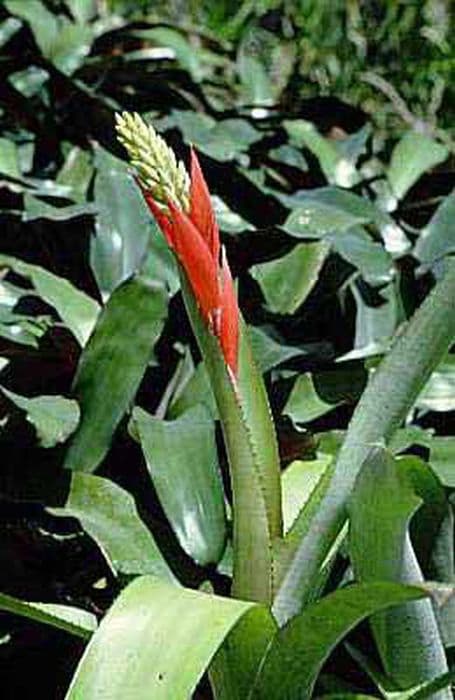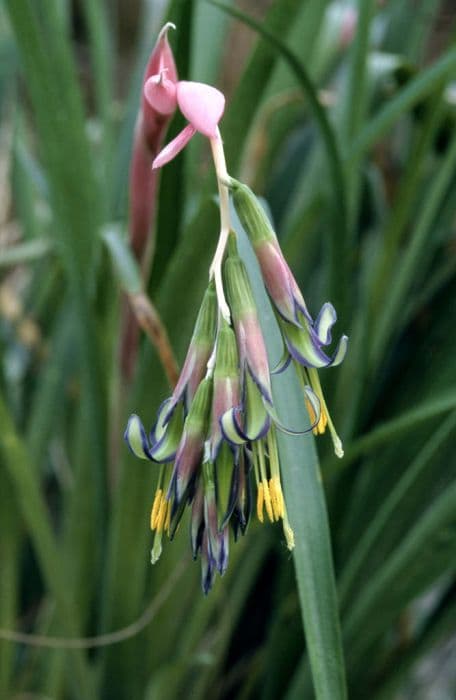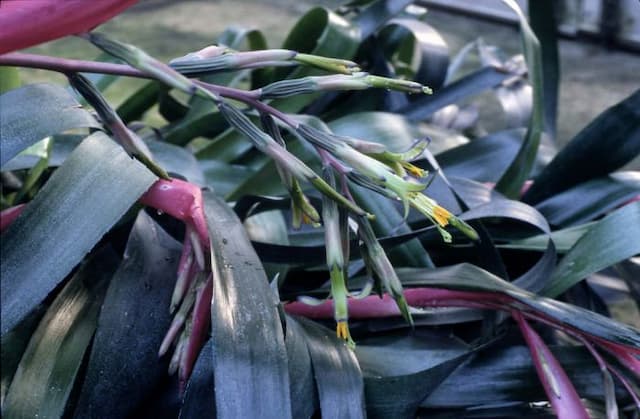Blue-flowered torch Tillandsia lindenii

ABOUT
T. lindenii is an evergreen plant forming a rosette of arching, linear leaves to 40cm in length, lined with purple; in late spring or autumn produces flattened spikes of overlapping pink bracts, from which emerge deep purple flowers 7cm in length
About this plant
 Names
NamesFamily
Bromeliaceae.
Synonyms
Blue-flowered Torch, Linden's Airplant, Airplant.
Common names
Tillandsia lindenii
 Characteristics
CharacteristicsLife cycle
Perennials
Foliage type
Evergreen
Color of leaves
Green
Flower color
Pink
Height
1 foot (30 cm)
Spread
1 foot (30 cm)
Plant type
Epiphyte
Hardiness zones
10
Native area
Central America
Benefits
 General Benefits
General Benefits- Decorative Appeal: Tillandsia lindenii, commonly known as Blue Flowered Torch, adds aesthetic value to homes and gardens with its vibrant blue or purple flowers.
- Low Maintenance: Blue Flowered Torch does not require soil to grow, making it relatively easy to care for with minimal watering and feeding.
- Diversity in Display: Being an epiphyte, the Blue Flowered Torch can be displayed in various ways, such as being mounted on different substrates or hung, providing creative decor options.
- Promotes humidity: Like many air plants, Blue Flowered Torch can help maintain favorable humidity levels in a home, which can be beneficial for comfort and other houseplants.
- Learning Opportunity: Cultivating Blue Flowered Torch provides a way to learn about the unique biology of epiphytic plants and their role in natural ecosystems.
- Non-Toxic to Pets: Blue Flowered Torch is non-toxic, making it safe to keep around pets.
 Medical Properties
Medical PropertiesThis plant is not used for medical purposes.
 Air-purifying Qualities
Air-purifying QualitiesThis plant is not specifically known for air purifying qualities.
 Other Uses
Other Uses- Decorative bridal bouquets or wedding centerpieces: Tillandsia lindenii, also known as Blue-flowered Torch, can add an exotic and long-lasting touch to wedding florals.
- Living art installations: Artists and interior designers sometimes incorporate Blue-flowered Torch into living wall art or sculptures due to its striking appearance and minimal soil requirements.
- Educational tools: Due to their unique properties, Blue-flowered Torch plants are often used in classrooms to teach about epiphytism and adaptation in plants.
- Jewelry making: The small size and interesting texture of Blue-flowered Torch make them suitable for creating living, wearable art such as brooches, necklaces, and earrings.
- Gift garnishes: A small Tillandsia lindenii can be tied to gift packages as a unique and eco-friendly alternative to traditional bows and ribbons.
- Cultural events: In some cultures, Blue-flowered Torch may be used during certain ceremonies or rituals for symbolic purposes related to air and life.
- Photography props: The distinctive look of Blue-flowered Torch makes it a popular choice for photographers seeking to add an unusual and natural element to their composition.
- Biological study: These plants can be subjects for studying symbiotic relationships, as they sometimes coexist with certain insects or microorganisms.
- Ornamental collections: Plant enthusiasts may cultivate Blue-flowered Torch as part of a specialized collection that showcases epiphytic or rare plants.
- Corporate gifting: Businesses looking for unique gifts might choose Blue-flowered Torch as a lasting and maintenance-friendly alternative to cut flowers.
Interesting Facts
 Feng Shui
Feng ShuiThe Air Plant is not used in Feng Shui practice.
 Zodiac Sign Compitability
Zodiac Sign CompitabilityThe Air Plant is not used in astrology practice.
 Plant Symbolism
Plant Symbolism- Resilience: Tillandsia lindenii, commonly known as the Blue-flowered Torch, is an air plant that doesn't need soil to grow, symbolizing adaptability and perseverance in challenging environments.
- Independence: The ability of the Blue-flowered Torch to sustain itself with minimal resources is often seen as a representation of self-reliance and autonomy.
- Air Purification: As an epiphyte, the Blue-flowered Torch is believed to cleanse the air around it, symbolizing purification and the removal of negative energy.
- Unconventional Beauty: With its unique growth habits and striking blue flowers, the Blue-flowered Torch is often associated with beauty that defies standard conventions and expectations.
 Water
WaterThe Blue Flowered Torch, more commonly known as the Air Plant, thrives when watered by misting two to three times a week. In drier conditions, soak the plant in a bowl of water for about an hour every two weeks. After soaking, turn the plant upside down to let excess water run off to prevent rot. During winter, reduce watering to once a week and ensure the water is at room temperature. Always use approximately 4 ounces of water for misting or enough to fully submerge the plant during soaking.
 Light
LightBlue Flowered Torch plants prefer bright, indirect sunlight. Indoors, place the plant near a south, east or west facing window where it receives bright light without being in the direct sun. If the light is too intense, diffused light with a sheer curtain is ideal to prevent leaf burn.
 Temperature
TemperatureThe Blue Flowered Torch can tolerate a temperature range from 50 to 90 degrees Fahrenheit, but it thrives in temperatures between 60 and 80 degrees Fahrenheit. Avoid exposing the plant to temperatures below 50 degrees for prolonged periods, as this can cause damage to the plant.
 Pruning
PruningPruning the Blue Flowered Torch is only necessary to remove dead or damaged leaves to maintain plant health and appearance. This can be done as needed, any time of the year, using clean, sharp scissors. Pruning also refreshes the plant and helps to promote new growth, but typically no heavy or regular pruning is required.
 Cleaning
CleaningAs needed
 Soil
SoilBlue-flowered Tillandsia thrives without soil; instead, use bark pieces or a non-soil epiphytic mix; ideal pH is not applicable as they do not require soil.
 Repotting
RepottingBlue-flowered Tillandsia does not need repotting as it is an epiphyte and grows without soil, typically mounted on a surface.
 Humidity & Misting
Humidity & MistingBlue-flowered Tillandsia prefers high humidity levels, around 60-70%, to thrive well indoors or outdoors.
 Suitable locations
Suitable locationsIndoor
For Blue-flowered Tillandsia, mount on wood, mist regularly, and provide bright, indirect light.
Outdoor
Mount Blue-flowered Tillandsia on trees or wood; ensure protection from intense sun.
Hardiness zone
Blue-flowered Tillandsia is suitable for 10-11 USDA hardiness zones.
 Life cycle
Life cycleTillandsia lindenii, commonly known as Linden's airplant, begins its life cycle when seeds, facilitated by a silky fluff called pappus, are dispersed by wind and land on a suitable substrate, typically another plant or a rocky surface. The seeds germinate, developing into small seedlings that anchor onto the substrate using root-like holdfasts, which serve primarily for attachment rather than nutrient absorption. Through the process of photosynthesis and nutrient uptake through their specialized leaves, the seedlings grow and mature into adult plants, forming dense rosettes of silver-green, scaly leaves. Linden's airplant absorbs water and nutrients from the air via tiny scales called trichomes. After reaching maturity, the plant produces a striking inflorescence ranging from deep blue to violet, typically signaling that the plant is in its blooming phase, which also marks the beginning of its reproductive stage. Following pollination, which can be performed by hummingbirds or other pollinators, the plant sets seed, completes its life cycle, and eventually dies, often after producing offsets, or "pups" that develop at the base of the plant, giving rise to the next generation.
 Propogation
PropogationPropogation time
Spring-Early Summer
The most popular method to propagate Tillandsia lindenii, commonly known as Blue-flowered Torch, is through the division of offsets, also called "pups." These pups usually form around the base of the mother plant after it has flowered. Once they're about one-third the size of the parent plant or have several roots, they can be gently twisted or cut off using a sterilized blade. The best time to propagate is during the growing season, which is spring or early summer. After separation, allow the pups to dry for a day, and then they can be mounted on a suitable substrate or placed in a lightly packed, fast-draining growing medium. They should be kept in bright, indirect light and watered regularly but allowed to dry out between waterings.









